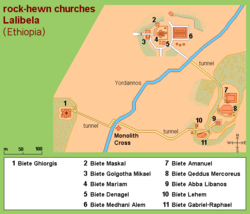Rock-hewn churches of Lalibela
| Rock-hewn churches of Lalibela | |
|---|---|
|
UNESCO world heritage |
|

|
|
| Offer Giyorgis |
|
| National territory: |
|
| Type: | Culture |
| Criteria : | (i) (ii) (iii) |
| Reference No .: | 18th |
| UNESCO region : | Africa |
| History of enrollment | |
| Enrollment: | 1978 ( session 2 ) |
The rock-hewn churches of Lalibela in Ethiopia are eleven churches that were carved out of the surrounding rock formation as monoliths around the year 1250 . Its construction was originally attributed to Emperor Lalibela , who wanted to build a "New Jerusalem " in the 12th century after Muslim conquests brought Christian pilgrimages to the Holy Land to a standstill. The holy city of Lalibela experienced its heyday after the fall of the empire of Aksum .
The churches are located in the central Ethiopian highlands near a village with traditional round dwellings. They still serve their original purpose and are visited by Ethiopian Orthodox pilgrims.
The church buildings have been registered as a UNESCO World Heritage Site since 1978 .
description
The churches can be divided into two main groups. North of the Jordan River: Offer Medhani Alem ( "House of the Redeemer of the world "), I offer Mariam ( "House of Mary"), I offer Maskal ( "House of the Cross"), I offer Denagel ( "House of virgins"), I offer Golgotha Mikael ("House of Golgotha Mikael"); and south of the river: Biete Amanuel ("House of Emmanuel"), Biete Qeddus Mercoreus ("House of Saint Mercoreos"), Biete Abba Libanos ("House of Abbot Libanos"), Biete Gabriel Raphael ("House of Gabriel Raphael") and Offer Lehem ("House of Holy Bread"). The eleventh church, Biete Ghiorgis ("House of Saint George "), is isolated from the others but connected to them by a system of moats.
The churches were not built in the traditional way, but carved from monolithic boulders. Doors, windows, columns, floors, roofs, etc. were carved out by further chiselling. Some of the interiors are decorated with wall paintings . A widely ramified system of drainage ditches and ceremonial passages was created around the churches , some with openings to hermit caves and catacombs .
Offer Medhani Alem with its five naves and a height of 33 meters is the largest monolithic church in the world, while offering Ghiorgis has a remarkable cross-shaped floor plan. Most of them were probably used as churches from the beginning, Biete Mercoreos and Biete Gabriel Rafael could once have been royal residences .
Not far from the churches is the village of Lalibela with two-story round houses built from local red stone known as Lasta Tukuls .
protection
Registration as a world heritage site
The churches of Lalibela were registered in 1978 as the first world cultural heritage site in Ethiopia on the list of UNESCO world heritage sites due to a resolution of the second session of the World Heritage Committee . The Simien National Park was also included as the country's first world natural heritage site.
The entry was made on the basis of criteria (i), (ii) and (iii).
(i): All eleven churches represent a unique artistic achievement in their design, size, variety and boldness of their shape.
(ii): The King of Lalibela decided to build a symbol of the Holy Land when the historical situation made pilgrimages there impossible. In the church of Biet Golgota there are replicas of the tombs of Christ and Adam and the nativity scene . The holy city of Lalibela became a replacement for the holy sites of Jerusalem and Bethlehem, and as such, had a significant impact on Ethiopian Christianity.
(iii): The entire city of Lalibela is an exceptional testimony to the medieval and post-medieval civilization of Ethiopia. In addition to the eleven churches, this also includes the numerous remains of traditional, two-story, round village houses with internal stairs and thatched roofs.
State of preservation
The drainage ditches were filled with earth for several centuries, then cleared in the 20th century and damaged by earthquakes . This has resulted in serious water damage , so that the monuments are in critical condition today. Biet Amanuel is in danger of collapsing due to static problems .
Serious damage to paintings in churches has occurred in the past thirty years . Also sculptures and bas-reliefs (z. B. at the entrance of Biet Mariam) were severely damaged, so that their original details are hardly recognizable.
Temporary protective devices have now been installed over some churches, but these impair the visual integrity .
Further threats to the World Heritage are threatened by the penetration of new public and private buildings in the vicinity of the churches, by residential buildings in the adjacent traditional village and by the expansion of the infrastructure for tourism .
literature
- Georg Gerster (collaboration: David Roden Buxton and others): Churches in the rock. Discoveries in Ethiopia. Kohlhammer, Stuttgart 1968, ISBN 3-7611-0389-1
Web links
- Entry on the UNESCO World Heritage Center website ( English and French ).
- The Ethiopian rock-hewn churches of Lalibela: Pilgrimage to a wonder of the world , Deutschlandfunk Kultur , August 12, 2018.
- Ethiopian Treasures (English)
- History of the Churches of Lalibela ( Memento of May 14, 2011 in the Internet Archive )
Individual evidence
- ↑ a b c d e f g h i Entry on the website of the UNESCO World Heritage Center ( English and French ).
- ^ Johanna Tirnthal: The Ethiopian rock-hewn churches of Lalibela: Pilgrimage to a world wonder. Deutschlandfunk Kultur , August 12, 2018, accessed on July 9, 2019 .
- ↑ Decision - 2 COM VIII.38. UNESCO World Heritage Center, 1978, accessed July 9, 2019 .
Coordinates: 12 ° 2 ' N , 39 ° 3' E





